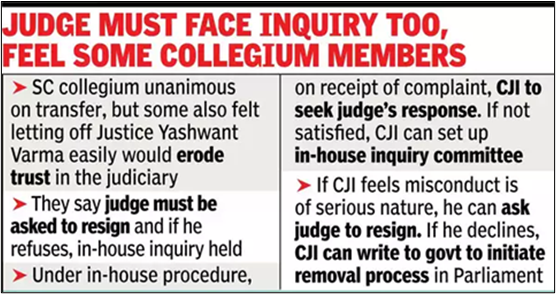PREVIOUS
In-House Inquiry Process for Judges in India
March 29 , 2025
30 days
159
0
- CJI has constituted an in-house committee to conduct an inquiry into allegations of misconduct against Justice Yashwant Varma.
- The resolution for in-house procedures for action against judges was adopted in 1999 and made public in 2014.
- When a complaint is received against a judge of a High Court, the CJI will decide whether the issue is frivolous or warrants an inquiry.
- If an inquiry is deemed necessary, the judge’s initial response along with the comments of the Chief Justice of the concerned High Court are taken on record.
- The CJI can them form a three-member committee consisting of the two Chief Justices from other High Courts and one High Court judge.
- The committee after completing the inquiry can provide a recommendation that the misconduct is serious enough to warrant removal or not serious enough.
- If the recommendation is not for the removal, then the judge would be apprised accordingly.
- However, if the recommendation is for the judge’s removal, he/she will be asked to resign.
- In the event of the judge unwilling to resign, the President and the PM will be informed of the findings for the Parliament to initiate action for removal as per provisions of the Constitution.
- Any complaint against the Chief Justice of a High Court, would be inquired by a committee consisting of a Supreme Court judge and two Chief Justices of other High Courts.
- In case of a complaint against a Supreme Court judge, the committee would consist of three Supreme Court Judges.

Leave a Reply
Your Comment is awaiting moderation.


